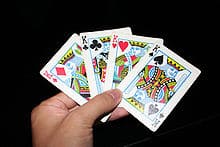Ninety-nine - addition card game
|
|
| Type |
Addingup-type |
| Players |
2+ |
| Cards |
52 (additional decks may be used) |
| Deck |
Anglo-American |
| Play |
Clockwise and Counter-clockwise |
| Card rank (highest to lowest) |
K Q J 10 9 8 7 6 5 4 3 2 A |
| Playing time |
15 min. |
| Random chance |
Low-Moderate |
| Related games |
| Switch |
Ninety-nine is a simple card game based on addition and reportedly popular among gypsies. It uses one or more standard decks of Anglo-American playing cards in which certain ranks have special properties, and can be played by any number of players. During the game, the value of each card played is added to a running total which is not allowed to exceed 99. A player who cannot play without causing this total to surpass 99 loses that hand and must forfeit one token.
Due to the simple strategy and focus on basic addition, the game is ideal for culturing math skills in children. This is also true because the new total must be called out with each play, lending enjoyment to more expressive children and assertiveness practice to others.
Gameplay
At the end
of the game, three tokens are distributed to each player. Each hand, three cards are dealt to each player, and the player to the left of the dealer takes the first turn by choosing one of the cards in their hand, places as a discard pile, calls out its value, and then draws a new card. The player to the left then chooses one of their cards and places it on the discard pile, adds its value to the previous card and calls out the new total. If a player forgets to draw a new card before the next player plays, that player must remain one card short for the remainder of the hand. Play proceeds in this manner until a player cannot play without making the total value greater than ninety-nine. That player must turn in one of his or her tokens, all cards are then collected and a new hand is dealt. Any player without tokens loses and is out of the game, while the last player remaining with token wins. A variation is to play with dollar bills, instead of tokens. The dollar bill is folded instead of giving a token. Five folds are allowed: all corners, then in half and after that player is out. The final player wins all the dollar bills.
Cards of certain ranks have special values or properties, which are:
- 4: value is 0 and the order of play is reversed. (once the game is down to two players the order is not reversed.)
- 3: value is 3 and the next player is skipped.
- 10: value is -10, or +10.
- 9: value is 99 no matter previous deck value.
- K: value is 0, therefore previous deck value remains unchanged and can be thought of as a pass. (Note some reverse the role of the K and 9).
Queens and Jacks are worth 10, Aces are worth 1 or 11, while all other cards have their face-value.
Alternate rules allow use of the Joker cards and rank the cards as follows:
- 9: value is 0.
- 10: value is -10 or +10.
- K: value is 0 and the order of play is reversed.
- Joker: value is 99 no matter previous deck value.
Queens and Jacks are worth 10, Aces are worth 1 or 11, while all other cards have their face-value.
Should a player run out of cards completely - due to forgetting to draw that player loses the hand the next time they would have to play a card.
Strategy
During each round of the game, the running total will eventually climb to 99, and once it has, it is not likely to decrease very much before someone is unable to play. The game's strategy, therefore, revolves around cultivating a hand that can survive for as long as possible once ninety-nine is reached. This consists of saving 10s, 4s, 9s, and kings while playing cards of large value. Another strategy is to raise the total to 99 early by use of the required card (usually a 9 or King depending on house rules) in the hopes of catching another player unprepared.
Strategy and rationale for keeping cards of various values ("the long game" where 99 is reached slowly)
- Least valuable: 5, 6, 7, 8 have no long-term value
- Worth considering: Ace, 2, 3, can be used effectively when the score is in the high 90s. The Ace potential value of 11 is almost never of strategic value.
- Most underrated: Jack and Queen. If someone plays a 10 (minus 10) against a 99, these will push it right back to 99
- Overrated: King only buys you one extra turn, hardly better than a 9 at end-of-game play. If you are forced to play a high-value card, prefer to throw out a King in favor of keeping a 4 or 10 in reserve.
- Most valuable: 4. Playing 4 (reversal) when the score is 99 buys you the most number of turns until you have to confront the 99 score
Strategy for the bold move ("the short game" where you play a 99 value card on the first hand)
- If you have a 99 value card and two other high-value cards (4, 10, King) then you already have the "best" possible hand and waiting to play the 99 value card is of no point.
Read more:
COMMENTS








